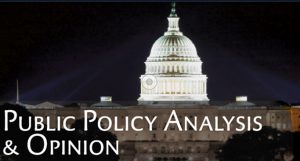 These include age, credit history,
These include age, credit history,
education level, gender, marital status, and more
“[T]he term ‘proxy factors’ refers to information about customers
that insurers might use in setting auto insurance premiums but that …
may not seem directly related to the hazards associated with,
or operation of, an auto.”
By Kevin P. Hennosy
This month, we reach deep into the beach reading file for Summer 2025.
The Federal Insurance Office (FIO) published a report earlier this year on personal lines automobile insurance. The report provides a cogent description of auto claims data, product features, pricing practices, and the regulatory oversight of the sector.
Of particular interest to those drawn to tales of insurance public policy (and who is not?) is an FIO discussion of the use of select rating elements in auto insurance pricing. The FIO report uses the term “Proxy Factors” to describe those select rating elements.
The report writers explained: “[I]n this Report the term ‘proxy factors’ refers to information about customers that insurers might use in setting auto insurance premiums but that may be beyond the customer’s control or may not seem directly related to the hazards associated with, or operation of, an auto.” Proxy factors include, but are not limited to; “age, credit history, education level, gender, and marital status.”
In short, the FIO surmises something long suspected by observers of insurance public policy: i.e., auto insurers use proxy factors to evade anti-discrimination laws. Furthermore, at the time of the report’s publication, the FIO wanted state officials to do something about the situation.
As an example of the proper regulatory approach to proxy factors, the FIO pointed to Oregon’s insurance regulatory regime. The report states: “Oregon has considered an alternate approach: expressly enumerating permitted underwriting factors (such as an applicant’s history of safe driving, number of miles driven, and driving experience) rather than prohibiting factors.”
Furthermore, “The Oregon Department of Consumer and Business Services states that this approach would eliminate the ability of insurers to use other, non-prohibited proxy factors that could replicate the disparate impact of the prohibited proxy factors.”
Of course, other states are not so strict.
For example, Iowa takes a different approach to insurance regulation. Rather than eliminate bad behavior, Iowa follows a “Buddy Regulator” methodology designed to ease the concerns of insurance carriers.
This is not to say that Iowa officials do not try to fulfill their regulatory obligations established by the McCarran-Ferguson Act. Legend has it that after the annual Iowa State Fair, the commissioner of insurance oversees the ritual slaughter of that year’s Butter Cow, and the carcass is examined for traces of “ectofluids” consistent with “a focused, non-terminal repeating phantasm, or a Class Five full roaming vapor.” (See the paranormal publications of Professor Ray Stantz.) Such a finding would cause the Hawkeye State Insurance Department to leap into regulatory action.
Iowa is not the only laboratory of democracy. My adoptive home state, Missouri, is called the Show Me State. Nevertheless, the state’s insurance regulators tend to shade their eyes when it comes to rating. Missouri is said to employ an after-the-fact “exam function,” which may or may not involve the ceremonial burning of insurers’ annual financial statements then analyzing the ashes for “bad attitudes.” Aggressive regulation left the Missouri state government when Superintendent Ben C. Hyde retired in 1929.
Now, do the two paragraphs above provide a fair and balanced description of the regulatory schemes of Iowa and Missouri? No way! Those paragraphs give form to a colorful rant by an unreconstructed liberal. However, those legends communicate the pre-modern beliefs held by many state regulators and legislators.
The FIO dabbles in some far-fetched beliefs, as well. The FIO insists on holding out hope that the National Association of Insurance Commissioners (NAIC) will play a positive role in improving the regulation of insurance.
The FIO port observed that the NAIC “has pointed out that state regulators may permit or prohibit rating factors as appropriate for their jurisdictions and that some states do prohibit certain types of proxy factors.” In other words, Oregon, as well as the legendary approaches of Iowa and Missouri, all meet the NAIC’s definition of excellence.
Credit
The FIO report raises another issue that the NAIC tries to avoid: Credit-Based Insurance Scores. The report establishes: “A credit-based insurance score is a proxy factor used by some insurers.” The NAIC has never found the gumption to make such a declarative statement.
Asking the NAIC to address issues like this one is akin to asking a herd of dairy cows to create a website. Surely, some of the members of the herd will show more acumen than others, but completion of the assignment will take a long time.
Occupation and education
Another alleged instance of the use of proxy factors concerns a policyholder’s occupation and education. The FIO report notes some states approve the use of occupation and education as factors in pricing, stating that there is “actuarial justification on the basis that drivers with more education take fewer risks and, as policyholders, they produce lower losses.” The report also issues a caveat questioning the “actuarial correlation, noting that ‘the inconsistent usage of these [education and occupation] factors casts doubt on their predictive ability.’”
“Some state regulators and legislatures have limited or prohibited the use of occupation or education levels as underwriting or rating factors. For example, the New York State Department of Financial Services (NYDFS) instituted limits on consideration of a driver’s work status or educational level after finding that there was no correlation between driving ability and income, occupation, or education level,” explained the FIO.
Homeownership
The FIO report observes, “Studies by consumer advocates state that most major auto insurers ‘penalize renters despite perfect driving records,’ charging good drivers as much as 47 percent more for basic liability insurance if they don’t own their home.”
Again, correlation between a proxy factor and financial loss is not poof of causation.
Gender
When this writer went to work for a multi-line insurance carrier in the mid-1980s, the orientation on auto insurance still included an assumption that “females drive fewer miles than males—such as, ‘the male in a couple always drives on a date.’” Well, that assumption went the way of the cassette tape deck, and probably the Victrola.
Still, the FIO report notes: “Statistics on vehicle crash fatalities resulting from risky behaviors (such as not wearing a seatbelt, speeding, and driving while impaired) also show that males have a higher incidence of fatalities.” So, the American male is still working hard to preserve lower auto insurance rates for women.
Marital status
“Consumer group studies have shown that single, separated, or divorced drivers pay more for auto insurance than do married drivers and that the continued use of marital status as a rating factor raises questions about fairness and proxy discrimination,” according to the FIO.
Nevertheless, the report notes; “Marital status, age, and gender are rating factors described by one insurance industry organization as ‘traditionally utilized, proved, and long accepted.’”
Porcine flight
In one of the more puzzling sections of the report, the FIO threw a suggestion at the NAIC’s insurance regulatory toybox in Kansas City:
The NAIC and its Center for Insurance Policy and Research should study and report on the use of proxy factors and its effect on auto insurance costs and availability and economic mobility, using quantitative data to inform this work. This research could assess how the use of proxy factors affects the cost of auto insurance for traditionally underserved communities and consumers, minorities, and low- and moderate-income persons.
It is as if the FIO staff believed that the NAIC and its shadow organization possess public virtue? Should someone tell them?
Elimination
Well, it might be too late for remedial education efforts for the FIO. By the time this issue of Rough Notes arrives at the mail house, the FIO’s phone numbers and email servers may not work. Some nameless functionaries in an information technology office may receive a charge to scrub the internet of all references to FIO.
Do not laugh. In January, Montana Congressman Troy Downing introduced the Federal Insurance Office Elimination Act.
According to a news release issued by Congressman Downing’s office, the legislation “received support from the National Association of Professional Insurance Agents (PIA), the National Association of Mutual Insurance Companies (NAMIC), and the Independent Insurance Agents & Brokers of America (Big “I”).
Now, keep in mind that passage of legislation consistent with the constitutional order takes time, which seems a quaint anachronism.
In December 2024, insurance commissioners from eight jurisdictions—Alabama, Arkansas, Kansas, Louisiana, New Hampshire, North Carolina, Oklahoma, Tennessee, and West Virginia—posted “a joint letter to the then-newly appointed leaders of the extra-statutory entity called the Department of Government Efficiency (DOGE). The letter urged DOGE to shut down the FIO.
If Representative Downing’s bill passes Congress and receives the president’s signature, the elimination of FIO will certainly stick. Any DOGE action will create a great number of billable hours for a gaggle of attorneys.
We live in interesting times.
The author
Kevin P. Hennosy is an insurance writer who specializes in the history and politics of insurance regulation. He began his insurance career in the regulatory compliance office of Nationwide and then served as public affairs manager for the National Association of Insurance Commissioners (NAIC). Since leaving the NAIC staff, he has written extensively on insurance regulation and testified before the NAIC as a consumer advocate.




